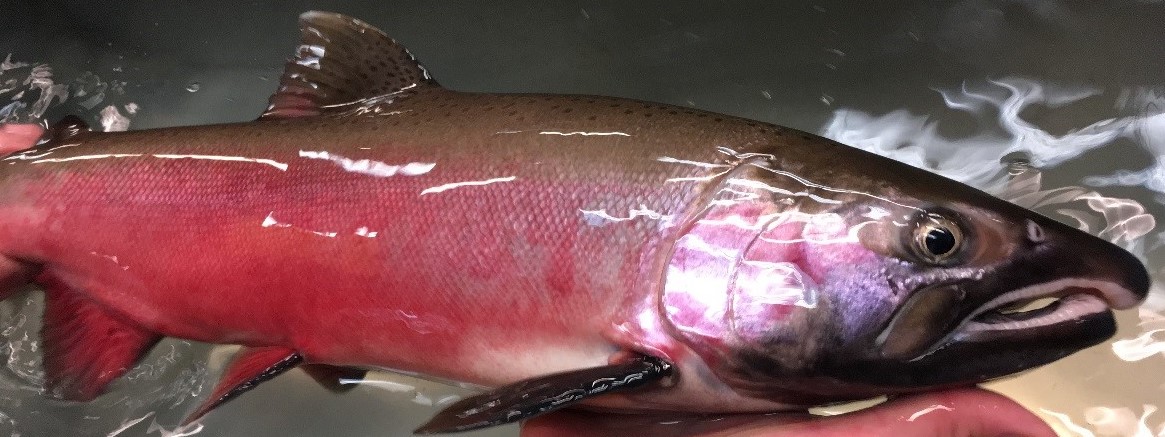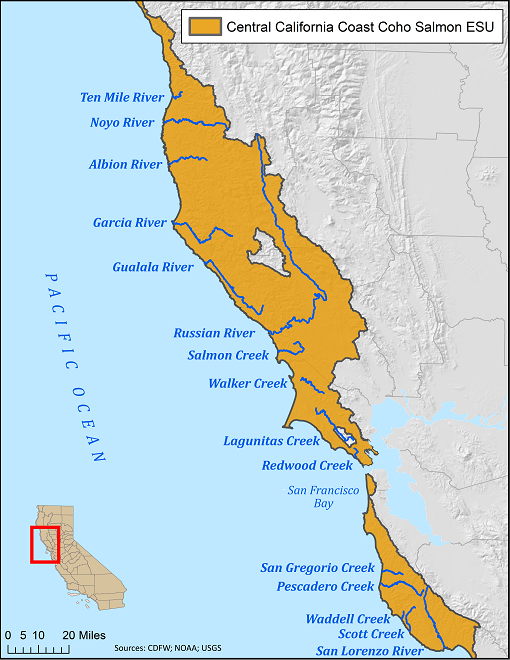Background and Status
 Adult Coho Salmon spawner at Warm Springs Hatchery. CDFW photo by Mary Olswang.
Adult Coho Salmon spawner at Warm Springs Hatchery. CDFW photo by Mary Olswang.
The Coho Salmon, sometimes called Silver Salmon, is one of five species of Pacific Salmon present in watersheds along the west coast of North America. In California, the fish live mostly in coastal watersheds, ranging from just north of Monterey Bay to the Oregon border.
Coho Salmon are in severe decline in most watersheds in the central California coast. This is due largely to human alterations to land and water resources, and many populations are now either extirpated (locally extinct) or approaching extirpation. In response, California Department of Fish and Wildlife (CDFW), along with National Oceanic and Atmospheric Administration (NOAA) Fisheries, and a range of regional stakeholders, have developed, and begun to implement, a wide range of new recovery initiatives to help prevent further population losses. The Priority Action Coho Team (PACT) initiative is specifically designed to accelerate the recovery of Coho Salmon populations in watersheds along the central California coast and so prevent further population losses.
 Map of California with habitat of CCC Coho Salmon outlined, as well as a few important CCC streams. CDFW map by Chester Lindley. (click/tap to enlarge)
Map of California with habitat of CCC Coho Salmon outlined, as well as a few important CCC streams. CDFW map by Chester Lindley. (click/tap to enlarge)
The PACT Process
PACT encompasses a range of watersheds in the central California coast, ranging from Cape Mendocino in the north to Santa Cruz County in the south. Included is the Russian River system in Sonoma County, the largest watershed in the central California coast. Coho Salmon are persisting in the river system with considerable help from the Russian River Coho Salmon Captive Broodstock Program, which is underway at Warm Springs Hatchery, located below Lake Sonoma.
The PACT program identifies and implements specific short-term actions, drawing from existing state and federal Coho Salmon recovery plans, which scientists believe will bring immediate benefits and prevent further population losses in coastal watersheds. The recommendations made by the PACT were developed by six Technical Working Groups (TWGs), comprising scientists from both CDFW and NOAA Fisheries, together with regional stakeholders, that met on a regular basis to identify immediate, short-term, high priority recovery actions related to:
- Habitat Restoration and Protection
- Captive Rearing and Fish Rescue
- Instream Flow and Conservation
- Regulations, Permitting and Enforcement
- Education, Outreach and Media Interaction
- Funding
Outcomes and Ongoing Efforts
The PACT 2019 Final Report (PDF)(opens in new tab) describes a suite of goals and recommendations, made by each of the TWGs, which are designed to help prevent further extirpations of Coho Salmon populations in central California coastal watersheds. Some examples of projects which have already been implemented include;
- Restoring and improving stream and estuarine habitat in coastal watersheds, such as Scott Creek, Santa Cruz County, and the Russian River, Sonoma County.
- Improving stream conditions to allow for improved fish passage to upstream spawning and rearing areas in coastal watersheds, such as Scott Creek and the San Lorenzo River.
- Improving stream flow and water quality conditions in affected coastal watersheds.
CDFW and NOAA Fisheries, with the assistance of regional stakeholders, will continue to develop and implement an expanded range of TWG recommendations to prevent any further population losses, so that future generations of Californians can continue to enjoy this remarkable fish.
An Addendum to the 2019 PACT report was completed in April 2024. The report highlights the status of the recommendations made by the Habitat Restoration TWG, the Captive Rearing and Rescue TWG, and the Instream Flow and Conservation TWG. A total of 225 habitat restoration projects benefiting Coho Salmon recovery in the Central California Coast was funded between 2011 and 2022 through the CDFW Fisheries Restoration Grants Program (FRGP). More than $70 million in FRGP funds were granted during this period to restoration projects benefiting Coho Salmon recovery.
Dr. Stephen Swales, CDFW
Statewide Coho Salmon Recovery Coordinator,
Stephen.Swales@wildlife.ca.gov